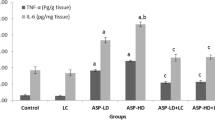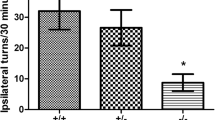Abstract
In the present study we investigated the effect of acute administration of L-arginine on Na+,K+-ATPase and Mg2+-ATPase activities and on some parameters of oxidative stress (chemiluminescence and total radical-trapping antioxidant parameter-TRAP) in midbrain of adult rats. We also tested the effect of L-NAME on the effects produced by arginine. Sixty-day-old rats were treated with an acute intraperitoneal injection of saline (group I, control), arginine (0.8 g/kg) (group II), L-NAME (2 mg/kg) (group III) or arginine (0.8 g/kg) plus L-NAME (2 mg/kg) (group IV). Na+,K+-ATPase activity was significantly reduced in the arginine-treated rats, but was not affected by other treatments. In contrast, Mg2+-ATPase activity was not altered by any treatment. Furthermore, chemiluminescence was significantly increased and TRAP was significantly decreased in arginine-treated rats, whereas the simultaneous injection of L-NAME prevented these effects. These results demonstrate that in vivo arginine administration reduces Na+,K+-ATPase activity possibly through free radical generation induced by NO formation.
Similar content being viewed by others
REFERENCES
Brusilow, S. W. and Horwich, A. 2001. Urea cycle enzymes. Pages 1909–1963, In: Scriver, C. R., Beaudet, A. L., Sly, W. S., and Valle, D. (eds), The Metabolic and Molecular Bases of Inherited Disease, 8th Ed, McGraw-Hill, Inc., New York.
Iyer, R., Jenkinson, C. P., Vockley, J. G., Kern, R. M., Grody, W. W., and Cederbaum, S. 1998. The human arginases and arginase deficiency. J. Inher. Metab. Dis. 21:86–100.
Lincoln, J., Hoyle, C. H. V., and Burnstock, G. 1997. Nitric oxide in health and disease, Biochemical Research Topics. Cambridge University Press, Cambridge.
Beckmam, J. S., Carson, M., Smith, C. D., and Koppenol, W. H., 1993. ALS, SOD and peroxynitrite. Nature 364, 584.
Lipton, S. A., Choi, Y. B., Pan, Z. H., Lei, S. Z., Chen, H. S. V., Sucher, N. J., Loscalzo, J., Singel, D. J., and Stamler, J. S. 1993. A redox basead mechanism for the neuroprotective and neurodestructive effects of nitric oxide and related nitroso compounds. Nature 364:626–632.
Dawson, V. L. and Dawson, T. M. 1996. Nitric oxide neurotoxicity. J. Chem. Neuroanat. 10:179–190.
Heales, S. J. R., Bolaños, J. P., Stewart, V. C., Brookes, P. S., Land, J. M., and Clark, J. B. 1999. Nitric oxide, mitochondria and neurological disease. Biochim. Biophys. Acta 1410:215–228.
Sarti, P., Lendaro, E., Ippoliti, R., Benedetti, P. A., and Brunori, M. 1999. Modulation of mitochondrial respiration by nitric oxide: investigation by single cell fluorescence microscopy. FASEB J. 13:191–197.
Brunori, M. 2001. Nitric oxide, cytochrome-c oxidase and myoglobin. Trends Biochem. Sci. 26:21–23.
Dawson, V. L., Dawson, T. M., London, E. D., Bredt, D. S., and Snyder, S. H. 1991. Nitric oxide mediates glutamate neurotoxicity in primary cortical cultures. Proc. Natl. Acad. Sci. 88:6386–6371.
Almeida, A., Heales, S. J. R., Bolanos, J. P., and Medina, J. M. 1998. Glutamate neurotoxicity is asociated with nitric oxidemediated mitochondrial dysfunction and glutathione depletion. Brain Res. 790:209–216.
Dawson, T. M., Hung, K., Dawson, V. L., Steiner, J. P., and Snyder, H. S. 1995. Neuroprotective effects of gangliosides may involve inhibition of nitric oxide synthase. Ann. Neurol. 37: 115–118.
Radi, R., Beckman, J. S., Bush, K. M., and Freeman, B. A. 1991. Peroxynitrite-induced membrane lipid peroxidation: the cytotoxic potential of superoxide and nitric oxide. Arch. Biochem. Biophys. 288:481–487.
Moreno, J. J. and Pryor, W. A. 1995. Inactivation of 1-proteinase inhibitor by peroxynitrite. Chem. Res. Toxicol. 5:425–431.
King, P. A., Adnerson, V. E., Edwards, J. O., Gustafson, G., Plumb, R. C., and Suggs, J. W. 1992. A stable solid that generates hydroxyl radical upon dissolution in aqueous solution: reaction with proteins and nucleic acids. J. Am. Chem. Soc. 114:5430–5432.
Ericinska, M. and Silver, I. A. 1994. Ions and energy in mammalian brain. Prog. Neurobiol. 43:37–71.
Lees, G. J. 1993. Contributory mechanisms in the causation of neurodegenerative disorders. Neuroscience 54:287–322.
Sato, T., Kamata, Y., Irifune, M., and Nishikawa, T. 1995. Inhibition of purified (Na+,K+)-ATPase activity from porcine cerebral cortex by NO generating drugs. Brain Res. 704:117–120.
Avrova, N. F., Shestak, K. I., Zakharova, I. O., Sokolova, T. V., and Leont'ev, V. G. 1999. The difference in the effect of glutamate and NO synthase inhibitor on free calcium concentration and Na+,K+-ATPase activity in synaptosomes from various brain regions. Neurochem. Res. 24:1101–1106.
Silva, C. G., Parolo, E., Streck, E. L., Wajner, M., Wannmacher, C. M. D., and Wyse, A. T. S. 1999. In vitro inhibition of Na+,K+-ATPase activity from rat cerebral cortex by guanidino compounds accumulating in hyperarginemia. Brain Res. 838:78–84.
Buchmann, I., Milakofsky, L., Harris, N., Hofford, J. M., and Vogel, W. H. 1996. Effect of arginine administration on plasma and brain levels of arginine and various related amino compounds in the rat. Pharmacology 53:133–142.
Nishikawa, T., Kirsch, J. R., Koehler, R. C., Bredt, S. D., Snyder, S. H., and Traystman, R. J. 1993. Effect of nitric oxide synthase inhibition on cerebral blood flow and injury volume during focal ischemia in cats. Stroke 24:1718–1724.
Buisson, A., Plotkine, M., and Boulu, R. G. 1992. The neuroprotective effect of a nitric oxide inhibitor in a rat model of focal cerebral ischaemia. Br. J. Pharmacol. 106:766–767.
Jones, D. H. and Matus, A. I. 1974. Isolation of synaptic plasma membrane from brain by combined flotation-sedimentation density gradient centrifugation. Biochim. Biophys. Acta 356: 276–287.
Tsakiris, S. and Deliconstantinos, G. 1984. Influence of phosphatidylserine on (Na+ + K+)-stimulated ATPase and acetylcholinesterase activities of dog brain synaptosomal plasma membranes. Biochem. J. 22:301–307.
Chan, K. M., Delfert, D., and Junger, K. D. 1986. A direct colorimetric assay for Ca+2-stimulated ATPase activity. Anal. Biochem. 157:375–380.
Gonzalez-Flecha, B., Llesuy, S., and Boveris, A. 1991. Hydroperoxide-initiated chemiluminescence: an assay for oxidative stress in biopsies of heart, Liver and muscle. Free Rad. Biol. Med. 10:93–100.
Lissi, E., Pascual, C., and Del Castillo, M. D. 1992. Luminol luminescence induced by 2-2′-Azo-bis(2-amidinopropane) thermolysis. Free Rad. Res. Commun. 17:299–311.
Bradford, M. M. 1976. A rapid and sensitive method for the quantitation of microgram quantities of protein utilizing the principle of protein-die binding. Anal. Biochem. 72: 248–254.
Jensen, J. and Nörby, J. G. 1988. Membrane-bound Na+,K+-ATPase: target size and radiation inactivation size of some of its enzymatic reactions. J. Biol. Chem. 263:18063–18070.
Boldyrev, A. A., Lopina, O. D., and Fedesova, N. U. 1990. Na+,K+-ATPase: radiation inactivation studies. Biochem. Int. 21:45–52.
Beckman, J. S. and Koppenol, W. H. 1996. Nitric oxide, superoxide, and peroxynitrite: the good, the bad, and the ugly. Am. J. Physiol. 271:1424–1427.
Rubbo, H., Radi, R., Trujillo, M., Telleu, R., Kalyanaramam, B., Bornes, S., Kirk, M., and Freeman, B. A. 1994. Nitric oxide regulation of superoxide and peroxinitrite-dependent lipid peroxidation. Formation of novel nitrogen-containing oxidized lipid derivatives. J. Biol. Chem. 269:26066–26075.
Brown, G. C. 1995. Reversible binding and inhibition of catalase by nitric oxide. Eur. J. Biochem. 232:188–191.
Asahi, M., Fujii, J., Suzuki, K., Seo, H. G., Kuzuya, T., Hori, M., Tada, M., Fujii, S., and Taniguchi, N. 1995. Inactivation of glutathione peroxidase by nitric oxide. Implication for cytotoxicity. J. Biol. Chem. 270:1035–21039.
Luperchio, S., Tamir, S., and Tannembaum, S. R. 1996. NO-induced oxidative stress and glutathione metabolism in rodent and human cells. Free Rad. Biol. Med. 21:513–519.
Lees, G. J. 1991. Inhibition of sodium-potassium-ATPase: a potentially ubiquitous mechanism contributing to central nervous system neuropathology. Brain Res. Rev. 16:283–300.
Author information
Authors and Affiliations
Rights and permissions
About this article
Cite this article
de Souza Wyse, A.T., Bavaresco, C.S., Bandinelli, C. et al. Nitric Oxide Synthase Inhibition by L-NAME Prevents the Decrease of Na+,K+-ATPase Activity in Midbrain of Rats Subjected to Arginine Administration. Neurochem Res 26, 515–520 (2001). https://doi.org/10.1023/A:1010912929042
Issue Date:
DOI: https://doi.org/10.1023/A:1010912929042




